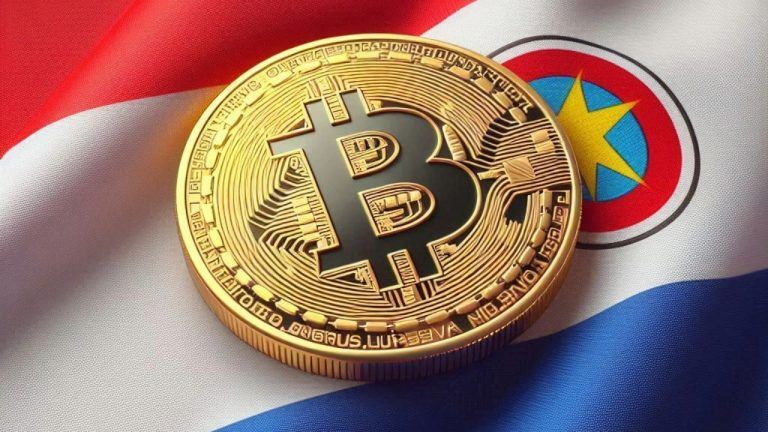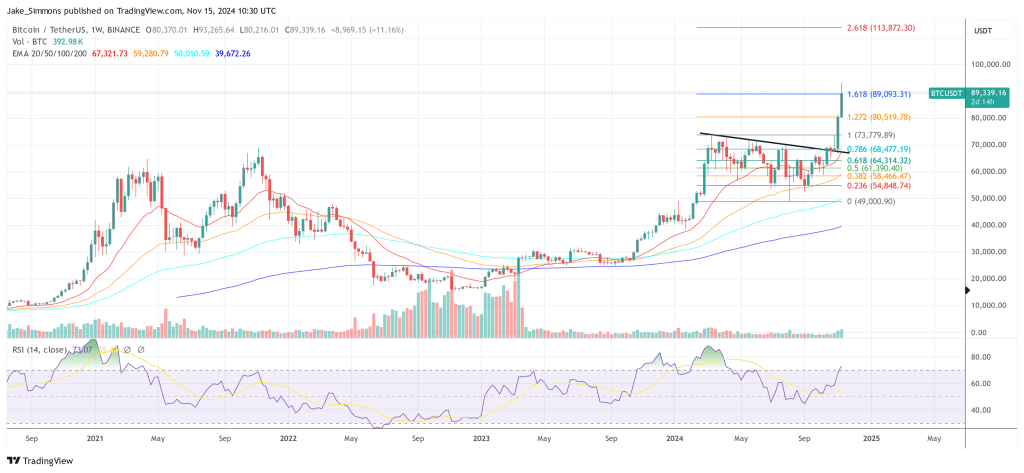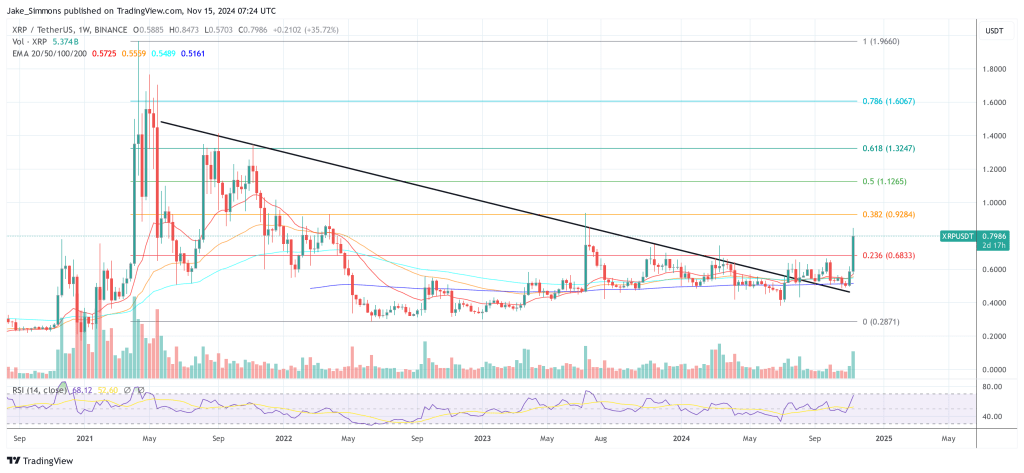CoinGeek’s Chief Bitcoin Historian Kurt Wuckert Jr. joined the No BS Crypto podcast to talk about the current industry, including Web 3.0, the history and future of Bitcoin, and much more. Watch it via the link or read a full written summary below.
Getting a job in web 3.0
No BS Crypto host Kyren begins by asking Wuckert what his advice is for someone looking for a job in Web 3.0. He replies that the computer science problems have largely been solved, so the best thing to do is start a business that solves real problems, using blockchain to solve a problem that can’t be solved another way.
The current climate in the industry
Wuckert gives his thoughts on the current digital currency industry. He says it’s not maturing; it’s gotten worse in the past few years. In fact, he still trusts the banks more than “crypto” people, explaining that criminals, grifters, and vipers are all the way down.
Considering who these people may be, Wuckert has a theory that many of them work on Wall Street and moonlight in the digital currency industry. He believes we’re in a bear market for at least the next year, and the dominos haven’t even begun to fall yet. Before we’re done, Wuckert believes we might see someone go to jail or face huge fines.
Will there be one blockchain to rule them all?
Wuckert acknowledges there will be one blockchain. He says the history of technology shows there are competing standards early on. For example, he asks us to look at the internet; there were many intranets early on, but ultimately, they came up with protocols and standardized them.
“Bitcoin was designed to remove friction,” Wuckert tells us, and only Bitcoin SV (BSV) still has these capabilities. There will still be other blockchains in the future, as there are still intranets, but they’ll be niche, whereas BSV will be like the internet.
Wuckert believes that BSV will win because companies will start doing their due diligence. For example, when they need to do a billion transactions a week on a public blockchain, they’ll find BSV. There’s no real competition.
Any advice for speculators?
Wuckert tells us to remember that everybody in the industry has a conflict of interest. Everyone has a strong opinion and is financially motivated to get you to agree with them in this industry.
Going further, he reminds us that the key to success in investing is being early and buying things when people think it’s crazy to do so. He says to invest your beer money, not your rent money, and make sure your financial life is taken care of. Likewise, he advises us to pay little attention to influencers out to line their pockets.
On Bitcoin as outlined in the white paper
Wuckert outlines Bitcoin as it was supposed to be per the 2008 white paper. First, he explains that Satoshi solved the double spending problem. He reminds us that the white paper opens by talking about commerce on the internet and deals with the problem of the cost of doing business on it.
Looking back, Wuckert reflects that when the white paper was released, the payment options were PayPal and credit cards. Satoshi stated that he thought a $5 minimum transaction was unacceptable and that small casual payments matter, and Bitcoin was his solution to this problem.
Wuckert reminds us that this isn’t a huge problem if you live in the ‘Anglosphere,’ or the richest half of the world. However, people who live on a lot less need to be able to spend $0.50 or less per transaction, and if they can spend that online between each other, that’s a huge deal. This is what Satoshi wanted to unlock, he tells us.
The popular narrative today is that all of this is false and that Bitcoin can’t solve the problem Satoshi outlined. BTC maximalists and influencers prefer to paint Bitcoin as a store-of-value and savings technology, but there’s no denying what Satoshi wrote. Sadly, most people don’t read what he wrote and simply see Bitcoin as a tool for speculation.
How has Bitcoin changed?
Wuckert points directly to governance in general. He says that not too many people talk about this. He explains how in modern nation-states, the intelligentsia makes decisions, and working people don’t have the time, energy, or sometimes knowledge to fight back. He outlines how it’s the same in Bitcoin; a small group of elite core developers has taken over the project. You’re made to feel that geniuses are in control and to leave it to them, but this isn’t how it was supposed to be.
Bitcoin is not supposed to be governed from above like this. It’s supposed to be governed by proof-of-work. Being in the mining business himself, Wuckert says that most miners lose money for years and make it back in bull markets, and that’s how it’s supposed to be because it ensures that people who really care about it have the most hash power on the network.
Proof-of-stake versus proof-of-work
Giving his thoughts on the proof-of-stake consensus mechanism, Wuckert says it’s both an overt and a subversive scam. While people like this because they think it’s efficient, in reality, it’s not because the incentives are misaligned.
In a proof-of-stake system, the rich get richer by holding the most tokens, and eventually, nobody can compete with them. “You will never catch up with whoever bought the most Ethereum first,” Wuckert reminds us. They’ll get exponentially richer and will be able to buy the value of everyone else, completely controlling the network for all time.
By contrast, with proof-of-work, whoever provides the most value wins. When they stop being the best, their blocks stop being built. This competitive system allows new entrants to challenge big players and gain an edge by innovating and competing.
Will an increase in hash rate lead to centralization?
Wuckert believes that hash power is going to go down over time. The block subsidy is reduced as time goes on, which disincentivizes raw hashing. Eventually, the subsidy will be replaced by transaction fees, he reminds us. Having a network with great connectivity and the maximum number of transactions is hugely important in this scenario. Clearly, BSV is built to win in this phase.
What incentivizes full nodes?
Wuckert states that data is money. “There is nothing more valuable than data,” he continues, noting that it’s the most undervalued commodity right now. There’s lots of value to be unlocked, and if you’re the person who controls the data, that’s where the money is in the long run. The ability to process it is a huge business opportunity.
Wuckert’s GorillaPool has mined blocks at 4GB. However, in his mind, that’s still small. He says that in 15 years, he believes they’ll be competing with AT&T and Verizon.
“They’ll swoop in suddenly,” he predicts.
The differences between BTC and BSV
Wuckert opens by explaining the Bitcoin civil war about how to scale Bitcoin. He recalls how the BTC Core developers made a fundamental change by removing the chain of digital signatures and replacing it with a hash of them outside the block—SegWit. This was controversial and caused the BCH split in August 2017. After some time, BCH developers wanted to make similar fundamental protocol changes, so BSV and BCH split. It’s important to note that this happened because BSV wanted to stay with the original design, whereas others didn’t.
With BSV, there’s no protocol to set block size limits, Wuckert reminds us. It’s up to the node operator to set the limits. Restoring the Bitcoin script stack also allows for smart contracts, general computation, and more, turning Bitcoin into a distributed computer. BTC and BCH developers have turned off many of these features, limiting what Bitcoin can do and giving rise to endless unnecessary blockchains.
BTC & BSV white papers and forks
Wuckert explains that the word fork is used in different ways in Bitcoin. It commonly means a copy and paste of the code with some tweaks. He explains that Bitcoin has an MIT license that allows such changes, but those who make such changes have to change their name. It’s open and flexible, just as Satoshi wanted, but you can’t just use the Bitcoin name.
Speaking about the various ‘soft forks,’ Wuckert explains that legacy Bitcoin nodes can’t validate almost any transactions that happen on them today.
“If Bitcoin isn’t a rules enforcement network, what is it?” he asks.
He says Litecoin is a true Bitcoin fork (note how it changed the name), and Bitcoin Cash is just a protocol scam. Drilling down on the difference between a protocol and an implementation, Wuckert gives the example of automobiles. The automobile is a protocol, whereas Ford and other brands are implementations.
These days, people want to define BTC as Bitcoin because it has the most hash power. Wuckert asks, “does nothing else matter?” For example, removing signatures literally breaks what Satoshi defined as a Bitcoin, yet people overlook that when dealing with BTC. If anyone brings this up, BTC advocates resort to tribalism and attacks. “They are afraid of people digging into the process,” Wuckert explains. By contrast, he is open and transparent because his ideas are thought out, and he doesn’t mind free discussion about them.
Why is BSV disliked so much?
Wuckert gives several reasons why BSV is delisted by most exchanges and hated by many industry influencers.
First, he notes that a lot of money is tied up in the idea that Bitcoin doesn’t scale. Billions of dollars have been invested in companies like Block, Lightning Labs, and similar firms. All of this is based on the idea that Bitcoin doesn’t scale and is a settlement technology. So, if Bitcoin can scale on-chain, there’s no reason for Blockstream or Lightning Labs to exist, and many people will lose money, he explains.
The second reason is BSVs association with Dr. Craig Wright. Wuckert says that if he’d been a small blocker, he’d be on the board at Blockstream and would be lauded. However, he’s a big blocker, and he says the small blockers like Adam Back are wrong, calling them out and refusing to comply with their wishes. Wuckert thinks he’s disliked because he doesn’t live up to their vision of what they imagined Satoshi to be. Rather than an altruistic anarchist, he’s a somewhat grumpy autistic Australian who is questioning what made many get rich for doing very little work.
Why don’t people believe Craig Wright is Satoshi?
Wuckert answers that most people are simply being told what to believe. On top of this, there are people like Arthur van Pelt who have written 100,000 words painting Dr. Wright as a scammer. Wuckert wonders who’s paying him since normal people don’t have the time to do this sort of thing.
Again, Wuckert emphasizes that people are defending their portfolios. Dr. Wright is like a snake in the garden; many people just want to get rid of him instinctually. However, Dr. Wright appears to love it and thrive on it. He doesn’t care for the opinions of his detractors and is independently wealthy. He’s a very long-term thinker and doesn’t care about the insignificant opinions of today.
What’s one piece of evidence to support Craig Wright’s claims?
According to Wuckert, the best evidence that Dr. Wright is Satoshi Nakamoto is that he hasn’t gone away. There’s so much money to be made by scamming in this industry, yet he has never raised funds, launched an ICO, or asked anyone for money. On the contrary, he tells people to cash out and stay away from speculating while working diligently in research and development. He stands on principles and doesn’t care about short-term profit.
Meanwhile, Michael Saylor from MicroStrategy (NASDAQ: MSTR), who lost $13 billion in the Dot Com crash, is encouraging people to mortgage their homes and buy BTC. In Wuckert’s mind, that’s what a scam looks like.
Digging deeper, Wuckert reflects that Bitcoin is an eccentric piece of technology. It involves economics, computer science, and several other disciplines. It just so happens that Dr. Wright is a polymath with high-level degrees in these areas.
Yet more evidence is how he explains features that BTC Core people shut off because they didn’t understand them. Dr. Wright explains in depth why they exist. Wuckert gives examples, citing how he described the reason for the double hash and that the Bitcoin script enabled smart contracts. He has been proven right about that when everyone else dismissed it.
IPv4/IPv6, micropayments, and IoT
Wuckert explains how Bitcoin and IPv6 can be integrated to create a new, truly peer-to-peer world. For those who don’t know, he explains that IPv4 was designed long ago and has run out of unique IP addresses. IPv6 is a solution because it allows exponentially more IP addresses to be created. IPv6 allows the transmission of peer-to-peer data rather than via servers as IPv4 necessitates. This will enable devices to send packets back and forth directly.
On BSV, direct peer-to-peer transactions are also possible. You then send it to the network to ensure it hasn’t been double spent. This way, IPv6 and Bitcoin can work together, allowing direct payments to be sent globally for the first time.
Watch: The BSV Global Blockchain Convention panel, The Future World with Blockchain
New to Bitcoin? Check out CoinGeek’s Bitcoin for Beginners section, the ultimate resource guide to learn more about Bitcoin—as originally envisioned by Satoshi Nakamoto—and blockchain.

You can get bonuses upto $100 FREE BONUS when you:
💰 Install these recommended apps:
💲 SocialGood - 100% Crypto Back on Everyday Shopping
💲 xPortal - The DeFi For The Next Billion
💲 CryptoTab Browser - Lightweight, fast, and ready to mine!
💰 Register on these recommended exchanges:
🟡 Binance🟡 Bitfinex🟡 Bitmart🟡 Bittrex🟡 Bitget
🟡 CoinEx🟡 Crypto.com🟡 Gate.io🟡 Huobi🟡 Kucoin.




















Comments